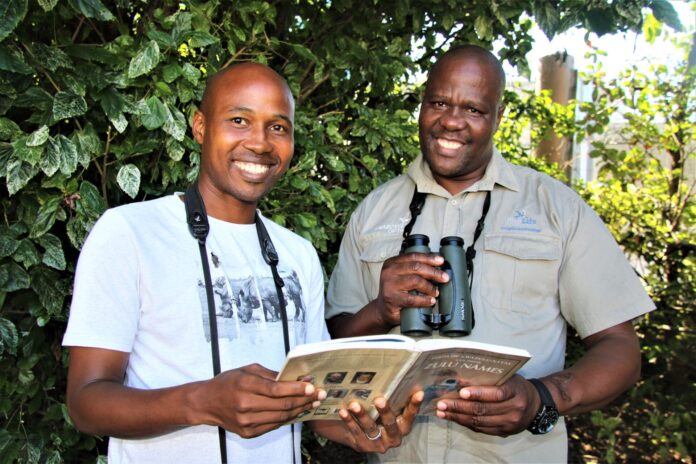Is it a bird? Is it a plane? Well, it’s both, really, as many birders from across the world jet in to spot KwaZulu-Natal’s (KZN) amazing birdlife every year.
As visitors to Africa’s Travel Indaba will find out, birding – otherwise known as avitourism or ornithological tourism – is one of the fastest-growing segments of the tourism market and enriches the province’s eco-tourism offering under the watchful eye of a knowledgeable network of community-based birding guides who keep a watchful eye over the KZN Birding Route.
Sakamuzi Mhlongo and Junior Gabela of Sakamuzi Bird Guides in Eshowe have been showing off the province’s feathered friends for decades. Both are accredited guides with Birdlife South Africa and, as representatives of the KZN Birding Route, are regular attendees at the Africa Travel Indaba. They are quick to point out that, with over 650 different bird species in exceptionally diverse habitats that stretch from coastal wetlands to African savannahs and the Drakensberg Mountains, KZN is the perfect destination for both domestic and international bird lovers.
A 2010 study by the Department of Trade notes that an estimated 8 000 and 16 000 international birders visited South Africa annually while between 21 000 and 40 000 local “twitchers” brought out their binoculars.
According to the study, avitourists’ spent between R927 million and R1,725 billion per year. Of this, domestic avitourists contributed between R482 million and R890 million, while international birders contributed between R309 million and R618 million. This adds up to a potential contribution to GDP of around R1,205 billion to R2,243 billion annually.
What tourism service providers tweeting about, is that travelling birders are believed to spend more than most other visitors, take longer trips and use experienced local tour guides to help them find unusual species. This presents an important opportunity to grow tourism and provide jobs in rural communities across KZN.
Mhlongo and Gabela are as familiar with the behaviour of tourists as they are with birds. The birding tourists that they host are split 50/50 between local and global. When Mhlongo started guiding 23 years ago, guests were mostly senior citizens. Now, bird watchers are younger.
Much of their marketing is done via social media and they get many return visitors. “People, with binoculars, which I took to see the Green Barbet 20 years ago are now returning with cameras. That’s now the big thing. We have a whole new market. People who have come back to take good photos are even returning for better shots,” he says.
He says that while travel restrictions due to the Covid-19 pandemic clipped their wings when it came to international birders, things have now returned to normal and guides have hosted growing numbers of local birders from Gauteng to Cape Town as well as enthusiasts from England, Canada, German and France over the past year.
A new aspect of his business has been collecting visitors and hosting birding tours for passengers on cruise liners that stopover in the port of Richards Bay.
Birding takes flight in Zululand
The Zululand Birding Route was the first Birdlife South Africa avitourism project and has been running for more than a decade. It is a network of 16 routes that offer a range of birding experiences that are grouped into four regions – North East Zululand, North West Zululand, Southern Zululand, and the North Coast.
It relies on over 30 local guides and a series of brochures and information packs linking the top 70 birding spots in the area across 14 local routes. These include the Dlinza Aerial Boardwalk, which is close to Eshowe, one of the finest places to spot birds (including the Palm-nut Vulture), hike and see Wild Fig and African plum trees.
Other top birding destinations include the Hluhluwe- iMfolozi Park, Mkuze, Ndumo, the Tembe Elephant Park, the Umlalazi Nature Reserve, the Ongoye Forest outside Mtunzini, the Isimangaliso Wetland Park and various privately owned reserves.
Mhlongo and Gabela say tourists and tour operators should never underestimate the value of local knowledge.
“In a single trip, I can set up a top 10 of special birds. If you come alone and search yourself, it will take five to six months. We will make your trip shorter because we know exactly where they are,” says Gabela.
When these two guides reach the end of their particular area, they simply pass on their birding customers to other guides who are experts in their particular habitats.
Spreading their wings across KZN
Birders in the Drakensberg can expect to see many of the 350 species. The Midlands Birding Route starts in the uKhahlamba-Drakensberg World Heritage Site and winds down through the foothills of the Drakensberg and over the rolling hillsides of the Midlands.
Highlights include the Hlatikulu Crane sanctuary, which is home to three different varieties of endangered cranes, the Falcon Ridge bird of prey centre in the Champagne Valley, Highmoor, which boasts the largest colony of breeding Bald Ibis in the Drakensberg, and the vulture hides at Giants Castle.
The Ugu South Coast offers a completely different and extremely diverse experience. Top spots include the Empisini Nature Reserve near uMkhomanzi, the TC Robertson Nature Reserve, the Crocworld Conservation Centre in Scottburgh, the Vernon Crookes Nature Reserve in Umzinto, Lake Eland Game Reserve at Oribi Gorge, Oribi Gorge Nature Reserve which follows the Mzimkulwana River as well as the Oribi Vulture Viewing Hide, which is considered one of the world’s best vulture viewing spots.
Other must-see stop-offs for birders are the River Valley Nature Reserve in Margate with its walking trails through riverine forest, the Red Desert Nature Reserve, one of the world’s smallest deserts at Port Edward, and Umtamvuna at Port Edward which is the southernmost nature reserve in the province and includes the beautiful Umtamvuna River surrounded by coastal and riverine forests, bushveld and cliffs.

